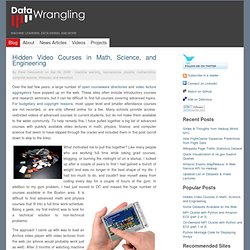

Folding. Crayon Physics: walkthrough, review, discussion, hints and tips at Jay is Games. The prototype Crayon Physics (Windows) from Kloonigames is part of Petri Purho's ongoing experiment to create games in less than a week to test new ideas.

Crayon Physics is one part Armadillo Run, one part Line Rider and tasks you with guiding a ball through a handful of stages by drawing shapes with a crayon-like cursor. Because of its rapid development time, Crayon Physics is a bit rough around the edges. But this downloadable title is stuffed with creativity and shows that with a good idea, anything is possible. In each of the seven levels in Crayon Physics, the ball starts on one side of the screen and one or more stars are placed across the stage. Obstacles sit in your way, of course, but your main enemy in this game is the vast open space that threatens to swallow the poor little ball. Dealing with the game's physics will be your chief goal, and you'll need to stack drop, slide and quick-draw to make it through each stage.
Get a little taste of creativity in its rawest form. Physics of Racing Series - Car Racing Game Physics. Cavendish experiment. The Cavendish experiment, performed in 1797–98 by British scientist Henry Cavendish, was the first experiment to measure the force of gravity between masses in the laboratory,[1] and the first to yield accurate values for the gravitational constant.[2][3] Because of the unit conventions then in use, the gravitational constant does not appear explicitly in Cavendish's work.

Instead, the result was originally expressed as the specific gravity of the Earth,[4] or equivalently the mass of the Earth; and were the first accurate values for these geophysical constants. The experiment was devised sometime before 1783[5] by geologist John Michell,[6] who constructed a torsion balance apparatus for it. However, Michell died in 1793 without completing the work, and after his death the apparatus passed to Francis John Hyde Wollaston and then to Henry Cavendish, who rebuilt the apparatus but kept close to Michell's original plan. The experiment[edit] Whether Cavendish determined G[edit] was known, N Tutorials. Hidden Video Courses in Math, Science, and Engineering " Data Wrangling Blog. Hidden Video Courses in Math, Science, and Engineering Over the last few years, a large number of open courseware directories and video lecture aggregators have popped up on the web.

These sites often include introductory courses and research seminars, but it can be difficult to find full courses covering advanced topics. For budgetary and copyright reasons, most upper level and smaller attendance courses are not recorded, or are only offered online for a fee. Many schools provide access-restricted videos of advanced courses to current students, but do not make them available to the wider community. To help remedy this, I have pulled together a big list of advanced courses with publicly available video lectures in math, physics, finance, and computer science that seem to have slipped through the cracks and included them in this post (scroll down to skip to the links).
What motivated me to pull this together? Enough motivation, on with the links: Physics Mathematics Machine Learning. Quake 3 BSP Collision Detection.